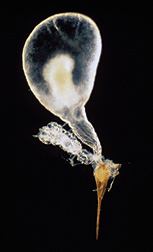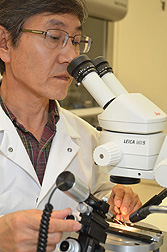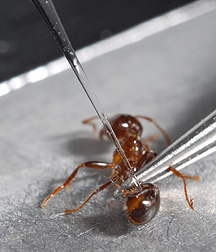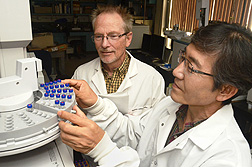Targeting Pheromones in Fire Ants
The painful sting of the red imported fire ant is not easily forgotten. Delivered in large numbers, the stings can kill small animals. Humans that develop hypersensitivity to the ants’ venom are at risk as well.
Unfortunately, the fire ant is well established in the southern and southwestern United States and is one of the world’s 100 worst invasive species. The pest affects U.S. urban, agricultural, wildlife, recreational, and industrial areas, infesting millions of acres and costing $7 billion in damage repair, medical care, and control each year. As the ants spread northward, Agricultural Research Service scientists at the Center for Medical, Agricultural, and Veterinary Entomology in Gainesville, Florida, stay close on their trail, exploring how they function and developing innovative techniques that could lead to new biologically based and environmentally friendly control methods.
One area under investigation are pheromones, chemicals secreted by ants to induce behaviors in other ants. For example, trail pheromones guide workers from nest to food sources, queen pheromones attract workers, and sex pheromones bring males and females together for mating. Entomologist Man-Yeon Choi and chemist Robert Vander Meer, in the center’s Imported Fire Ant and Household Insect Research Unit, have demonstrated for the first time that a neuropeptide hormone, originally discovered in moths, activates the production of trail pheromones. Worker ants lay a chemical trail from food to nest and recruit other workers to follow the trail to retrieve the food.
Following the Trail
The hormone of interest is called “pheromone biosynthesis activating neuropeptide” (PBAN). It was first discovered and identified in moths by ARS scientists in Beltsville, Maryland, in the 1980s. They found that PBAN regulates sex pheromone production in female moths.
According to Choi, every insect investigated so far has a variation of this neuropeptide—a compound made of two or more amino acids. “More than 200 PBAN-like peptides have been identified in other insects, such as cockroaches, but their pheromone biosynthesis activation function outside of moth species was unknown until now,” he says.
|
|
In one experiment, scientists injected fire ant workers with their specific PBAN to see if this process influenced the biosynthesis of the trail pheromone. Results demonstrated that there was a significant increase in pheromone production after injection.
In addition to the fire ant-specific PBAN gene, they also identified the DNA sequence of the fire ant PBAN receptor gene. With this information, they determined that the receptor gene was being expressed in the Dufour’s gland, which produces the trail-making pheromone.
Silencing Genes To Determine Their Function
Having determined the sequence of the genes, Vander Meer and Choi used the relatively new technique of RNA interference (RNAi) to provide another test of the role PBAN plays in fire ant trail pheromone production.
“RNAi technology involves taking normally single-stranded RNA from a gene and creating double-stranded RNA (dsRNA) that can be used to suppress expression of the gene,” Vander Meer explains.
Scientists dissolved the dsRNA of PBAN or its receptor in a water solution, injected it into ants, and made observations at 24, 48, and 72 hours after injection.
“When we used RNAi to suppress expression of either the PBAN gene or the PBAN receptor gene, the ants produced less trail pheromone” than ants that did not receive the treatment, Vander Meer says. These results confirmed that PBAN is involved in trail pheromone biosynthesis in the fire ant; therefore this function is not restricted to moths, he says.
|
|
Using RNAi for Insect Control
While the above research was not directed at controlling fire ants, prevention of trail pheromone production could limit the ant’s survival in terms of collecting resources, migration, and other activities, Vander Meer says. But the team also discovered that the PBAN gene is expressed in every stage of the fire ant’s life cycle, which suggests that the gene has functions beyond pheromone production.
Choi and Vander Meer demonstrated this by suppressing expression of the PBAN gene in fire ant larvae, pupae, and adults, and then looking for any observable impact on treated ants. They found significantly greater mortality in PBAN RNAi-injected adults and larvae than in the untreated controls. Injected pupae showed delayed development as well as a high death rate.
“This gene has many different roles. When we disrupt the expression of it with RNAi, we observe multiple effects in immature stages as well as in adults,” Vander Meer says.
Most importantly for future fire ant control efforts, brood-tending workers that fed on PBAN RNAi dissolved in sugar water regurgitated the RNAi to their hungry brood, which in turn died at a high rate, he says.
|
|
Collaborating with an industry partner, the scientists extended the fire ant PBAN RNAi work to the corn earworm—a moth species and a serious crop pest.
“Our moth study was very extensive,” Vander Meer says. “We fed the PBAN RNAi to corn earworms in their standard laboratory diet, and it had dramatic effects.” Those effects included a decrease in growth rate and the inability to develop from larvae into pupae. Female moths that survived to adulthood had decreased amounts of sex pheromone.
A patent has been awarded to ARS for the use of RNAi to control ant species. Three additional patent applications have been filed for RNAi suppression of the PBAN gene or its receptor gene in fire ants and moths.
Scientists plan to investigate whether other pheromones are activated by PBAN. Work on the use of RNAi to control insects continues under a cooperative research and development agreement with a private-industry partner.—By Sandra Avant, Agricultural Research Service Information Staff.
This research is part of Veterinary, Medical, and Urban Entomology (#104), an ARS national program described at www.nps.ars.usda.gov.
Man-Yeon Choi is now in the USDA-ARS Horticulture Crops Research Unit, 3420 N.W. Orchard Ave., Corvallis, OR 97330; (541) 738-4026.
Robert Vander Meer is in the USDA-ARS Imported Fire Ant and Household Insect Research Unit, Center for Medical, Agricultural, and Veterinary Entomology, 1600 S.W. 23rd Dr., Gainesville, FL 32608; (352) 374-5855.
"Targeting Pheromones in Fire Ants" was published in the April 2014 issue of Agricultural Research magazine.










